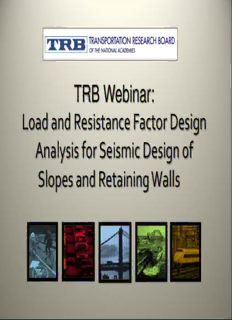
Seismic Hazard Levels PDF
Preview Seismic Hazard Levels
TRB Webinar: Load and Resistance Factor Design Analysis for Seismic Design of Slopes and Retaining Walls TRB Announcements: We have emailed you the presenters’ slides in today’s webinar reminder email. Upcoming webinars: Practices for Roadway Tunnel Design, Construction, Safety and Inspection, and Rehabilitation: March 4, 2 PM EST Nighttime Seat Belt Enforcement: Background and Recent Findings: March 9, 2 PM EST More: http://bit.ly/TRBwebinar Follow TRB on Twitter @TRBofNA http://twitter.com/TRBofNA Today’s Presenters and Moderator Mike Keever, California Department of Transportation, [email protected] Edward Kavazanjian, Arizona State University, [email protected] Donald Anderson, CH2MHill, [email protected] Geoffrey Martin, University of Southern California, [email protected] TRB Webinar Load and Resistance Factor Design for Seismic Design of Slopes and Retaining Walls sponsored by TRB Committee AFF50 Seismic Design of Bridges February 17, 2010 11 Overview of Presentation Presenters Facilitator Mike Keever/Caltrans Speakers Ed Kavazanjian/ASU Don Anderson/CH2M HILL Geoff Martin/USC Reference documents NCHRP Report 611 (Volumes 1 and 2) Seismic Analysis and Design of Retaining Walls, Slopes & Embankments, and Buried Structures NHI Course 130094 (in preparation) LRFD Seismic Design of Geotechnical Transportation Structures and Foundations 22 Overview NCHRP 12-70 Project http://www.trb.org/Main/Blurbs/Seismic_Analysis_and_Design_of_Retaining_Walls_Bur_160387.aspx or type “NCHRP 611” into Google or Bing 33 Overview Objectives of NCHRP 12-70 Project Develop methods for LRFD seismic design of retaining walls, buried structures, slopes, and embankments Develop recommended specifications compatible and consistent with AASHTO LRFD Bridge Design Specifications Ref: NCHRP Research Project Statement Project 12-70, FY 2004 44 Overview Need for NCHRP 12-70 Project Difficulties with retaining wall seismic design M-O method “blows up” with high back slopes, high PGA’s, not appropriate for passive Appropriate seismic coefficient Soldier pile, tieback, soil nail, and MSE walls Lack of guidance for slope stability Pseudo-static versus deformation approach Appropriate seismic coefficient Ground motion amplification Liquefaction effects 55 Outline of Presentation Background for methodology - Kavazanjian Seismic slope stability - Anderson Retaining wall design - Martin 66 Outline of Presentation Background for methodology AASHTO seismic damage philosophy Load and resistance factor design principles Design ground motions Seismic slope stability Factor of safety (C/D) approach Displacement-based approach Liquefaction issues Mitigation Retaining wall design Earth pressure determination External, internal, and global stability Guidance on AASHTO wall design 77
Description: